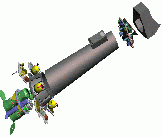 An
exploded view of the XMM Newton Observatory
An
exploded view of the XMM Newton Observatory
XMM Newton consists of 3 co-aligned grazing-incidence X-ray telescopes plus a co-aligned 30cm optical/UV telescope, allowing for simultaneous X-ray and optical/UV observations.
The powerful combination of high sensitivity, excellent spectral resolution and broad spectral band offered by XMM is certain to lead to major advances in many key areas.
More information on XMM can be obtained from the official XMM Science Operations Centre.
 An
exploded view of the XMM Newton Observatory
An
exploded view of the XMM Newton Observatory
XMM Newton consists of 3
co-aligned grazing-incidence X-ray telescopes plus a co-aligned 30cm optical/UV
telescope, allowing for simultaneous X-ray and optical/UV observations.
XMM Newton has 3 instruments:
The spatial resolution of the X-ray mirror modules is ~7" FWHM and ~15" HEW. The collecting area per X-ray module is ~ 1500 cm2 @ 1keV and 800 cm2 @ 6keV.
EPIC, the prime XMM instrument, covers a region of ~30' diameter, but vignetting increases to ~50% beyond a radius of 12'. The pixel sizes of the EPIC X-ray CCDs over-sample the mirror PSF thus providing optics-limited performance.
The expected positional accuracy for EPIC X-ray source detections will be ~2-5" (90% confidence) except for sources very close to the confusion limit where confusion "noise" will increase the positional uncertainties.
The RGS and the OM fields of view are 5' and 17' respectively. For most fields the RGS will provide data only for the primary target. The main purpose of the OM is to provide simultaneous optical/UV monitoring of the X-ray target.
For a fraction of all XMM observations, depending on the set-up chosen by the proposer, the OM will also obtain optical and/or UV imaging of the central part of the EPIC field with effective resolution ~1" down to limiting magnitudes ~22-23 in the blue (there is no red sensitivity).
For a subset of observations the OM data will thus be a valuable additional resource for the XID programme (particularly in providing UV coverage).
Overall,
however, the OM data will typically not go deep enough in the optical to
satisfy the main requirements of the XID programme, and the limited OM
field of view means that, at best, OM data will be available for 30-40%
of the EPIC field.
Last modified
10th March 2000
Text based on
AXIS proposal by X.Barcons and the SSC consortium.
Page designed
by J.Verdon and maintained by www_astro@mssl.ucl.ac.uk